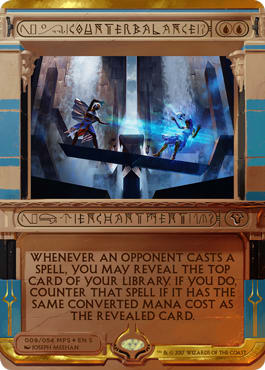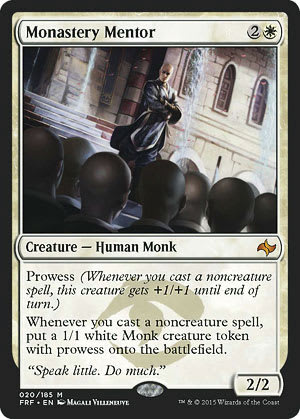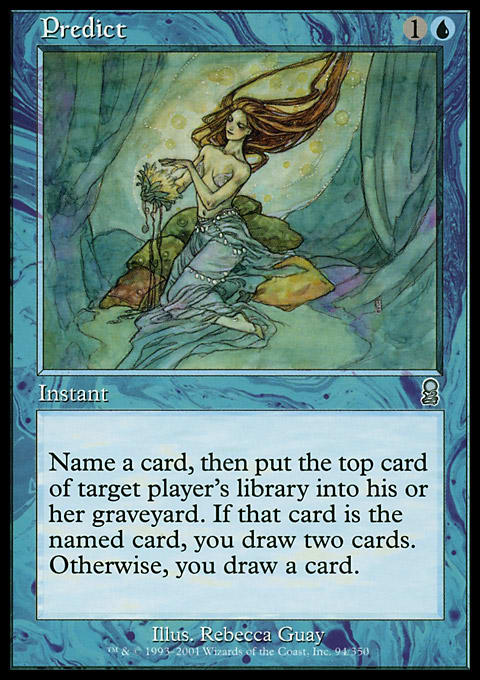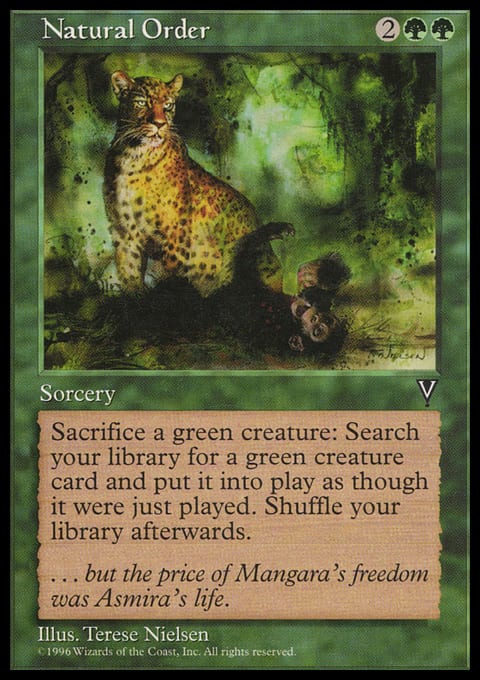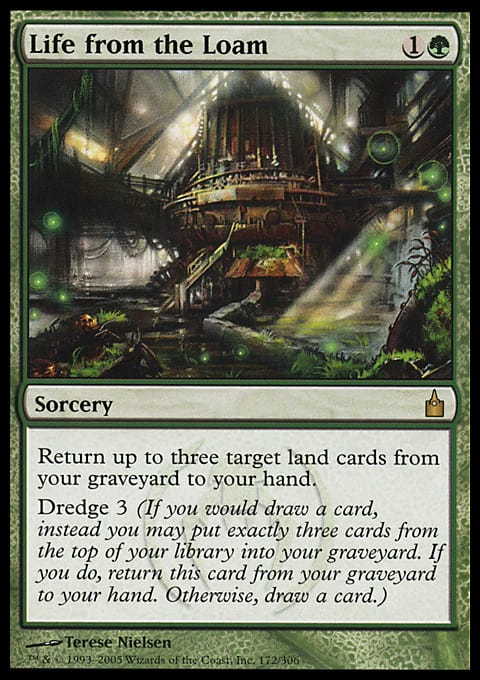Like many of you, I woke up to some rather unexpected news this past Monday. For the first time since Dig Through Time, Legacy has received a major shakeup, and the pieces of the format are all in disarray. Let’s talk about why the Top banning happened, and then dive into where Legacy goes from here.
Why Ban Sensei’s Divining Top?
Ever since the printing of Counterbalance in 2006, Sensei's Divining Top has gone from a cheap, color-agnostic card advantage engine to a critical piece of an unfun lock that ends the game for many decks on the spot. Its earliest (and in my eyes, still the best) adoption in Legacy, of course, was in a deck that would look silly by today’s standards, the off-the-charts busted Flash Hulk deck, which took down Grand Prix Columbus in 2007 in the hands of Steve Sadin.
Hulk Flash! ? Legacy | Steve Sadin, GP Columbus 2007
- Creatures (12)
- 1 Body Snatcher
- 1 Carrion Feeder
- 1 Karmic Guide
- 1 Kiki-Jiki, Mirror Breaker
- 4 Dark Confidant
- 4 Protean Hulk
- Instants (21)
- 1 Echoing Truth
- 4 Brainstorm
- 4 Daze
- 4 Flash
- 4 Force of Will
- 4 Mystical Tutor
- Sorceries (1)
- 1 Massacre
- Enchantments (4)
- 4 Counterbalance
- Artifacts (8)
- 4 Chrome Mox
- 4 Sensei's Divining Top
- Lands (14)
- 1 Swamp
- 3 Island
- 1 Tropical Island
- 1 Tundra
- 1 Underground Sea
- 3 Flooded Strand
- 4 Polluted Delta
- Sideboard (15)
- 4 Leyline of the Void
- 3 Massacre
- 4 Quirion Dryad
- 1 Reverent Silence
- 3 Swords to Plowshares
Mystical Tutor, Counter-Top, Force of Will, and Daze, and a potential turn-one win? A sideboard juke ready to switch game plans when opponents show up with combo hate? We won’t spend too much time on this monster, but let me tell you, when Counterbalance and Sensei's Divining Top are just a tertiary game plan, you’re doing something that might raise eyebrows at Wizards of the Coast. A full twelve of these cards are now banned in Legacy, which shows you just how far the format has come in the last ten years.
After the banning of Flash, though, Counter-Top took a fairly quiet role among strategies in Legacy. It was a part of Four-Color good stuff decks, like Gabriel Nassif’s Grand Prix Chicago winner, seen here:
Four-Color Good Stuff ? Legacy| Gabriel Nassif, 1st GP Chicago
- Creatures (12)
- 2 Sower of Temptation
- 2 Trygon Predator
- 4 Dark Confidant
- 4 Tarmogoyf
- Instants (16)
- 1 Krosan Grip
- 3 Daze
- 4 Brainstorm
- 4 Force of Will
- 4 Swords to Plowshares
- Sorceries (2)
- 2 Ponder
- Enchantments (4)
- 4 Counterbalance
- Artifacts (6)
- 2 Vedalken Shackles
- 4 Sensei's Divining Top
- Lands (20)
- 2 Island
- 3 Tropical Island
- 3 Tundra
- 4 Flooded Strand
- 4 Polluted Delta
- 4 Underground Sea
- Sideboard (15)
- 1 Relic of Progenitus
- 1 Tormod's Crypt
- 1 Burrenton Forge-Tender
- 1 Energy Flux
- 1 Engineered Plague
- 1 Planar Void
- 1 Threads of Disloyalty
- 1 Blue Elemental Blast
- 1 Darkblast
- 1 Enlightened Tutor
- 1 Hydroblast
- 1 Krosan Grip
- 1 Umezawa's Jitte
- 1 Kataki, War's Wage
- 1 Perish
However, Goblins as a whole archetype was generally powerful against Counterbalance midrange strategies, as they could slip under the lock with Aether Vial and harass the midrange player’s mana with Wasteland and Rishadan Port. There were also supercharged strategies centered around cards like the now-banned Survival of the Fittest and Mystical Tutor, as well as the brief interlude where Mental Misstep made Standstill the Blue control enchantment du jour. Ah, the glory days! I say, bring ‘em all back and let’s see how Mystical Tutor Storm fares against Bant Survival, but then again, I enjoy a bit of degeneracy from time to time.
What I’m getting at, in essence, is that a string of overpowered cards kept Sensei's Divining Top in the background for portions of Legacy’s existence, and before the printing of Terminus and Entreat the Angels in 2012, Counter-Top was more of a side package than the main attraction. Stoneforge Mystic and Batterskull were the inseparable partners in crime for ![]()
![]() -based control decks, and for a short period of time, Miracles shared the top spot with Stoneblade decks in the Legacy metagame. Hell,
-based control decks, and for a short period of time, Miracles shared the top spot with Stoneblade decks in the Legacy metagame. Hell, ![]()
![]()
![]() Threshold/Delver decks did a stellar job of keeping Miracles players honest, and the decks were still all underdeveloped and imperfect. In the early days of the SCG Open circuit, Miracles was just another competitor in a sea of uncertainty, where the preferences of some individual players made such an impact on the metagame that they were able to keep Miracles from being the clear best deck. In all honesty, if every one of the perennially successful Legacy aficionados had picked up Miracles from the start, we would have seen a Top ban years ago.
Threshold/Delver decks did a stellar job of keeping Miracles players honest, and the decks were still all underdeveloped and imperfect. In the early days of the SCG Open circuit, Miracles was just another competitor in a sea of uncertainty, where the preferences of some individual players made such an impact on the metagame that they were able to keep Miracles from being the clear best deck. In all honesty, if every one of the perennially successful Legacy aficionados had picked up Miracles from the start, we would have seen a Top ban years ago.
As it stood, though, Wizards juiced up Sultai-based decks immediately after creating Miracles, with both Deathrite Shaman and Abrupt Decay working overtime to provide a comparable level of power, while offering a clean answer to the Counter-Top lock. Though these cards began a process which pushed old-school ![]()
![]()
![]() Delver out of the format, they did provide an alternative for Brainstorm aficionados that kept Miracles’ numbers down. And for a while, things were fairly calm and steady, with a balance of various Blue tempo, midrange, and combo decks pressuring Miracles players from all angles, and all jockeying for metagame share. Hell, we even had a brief diversion in late 2014 when Khans of Tarkir (and the associated Treasure Cruise and Dig Through Time) juiced up Delver tempo decks to the point where they were unquestionably the most powerful choices in the format. Again, we see that other more ostensibly broken cards provided cover for Miracles as a format hog. The combination of intermittent printing of busted cards, the slow-moving nature of Legacy, and the entrenched players who will never change decks no matter what kept Miracles from being obviously “too good”. That started to shift with the adoption of a new card, then very recently with the adoption of one very old card.
Delver out of the format, they did provide an alternative for Brainstorm aficionados that kept Miracles’ numbers down. And for a while, things were fairly calm and steady, with a balance of various Blue tempo, midrange, and combo decks pressuring Miracles players from all angles, and all jockeying for metagame share. Hell, we even had a brief diversion in late 2014 when Khans of Tarkir (and the associated Treasure Cruise and Dig Through Time) juiced up Delver tempo decks to the point where they were unquestionably the most powerful choices in the format. Again, we see that other more ostensibly broken cards provided cover for Miracles as a format hog. The combination of intermittent printing of busted cards, the slow-moving nature of Legacy, and the entrenched players who will never change decks no matter what kept Miracles from being obviously “too good”. That started to shift with the adoption of a new card, then very recently with the adoption of one very old card.
Monastery Mentor was the first contribution to Miracles that put it in a class above the rest. For the longest time, Miracles had a humongous weakness: it simply couldn’t close out games fast enough to consistently finish a three-game match in under 50 minutes. There is simply so much deck manipulation inherent to the Sensei's Divining Top gameplay, combined with frequent use of fetchlands and a low number of win conditions, that only the fastest, most competent pilots were able to finish all of their matches in time. Mentor changed that a lot, by providing a midgame threat that quickly closed things out without needing to invest six or seven mana in a big Entreat the Angels. Mentor also stretched opposing Abrupt Decays a bit thinner, because most opponents could not realistically keep in more creature removal spells against a deck with only four or five total targets. (An aside, it was this tension that led me to start keeping in two or even three Lightning Bolts as a Delver player against Miracles. Not only did they have very little lifegain in their deck, but killing Jace or Mentor is a big game.)
So, Monastery Mentor helped push Miracles up a level in terms of the consistency with which it could finish a locked-out opponent, but Wizards printed the Eldrazi, Leovold, Emissary of Trest, Sanctum Prelate, Palace Jailer, and True-Name Nemesis as stellar creatures that put Miracles players in a squeeze from a number of different archetypes. Leovold singlehandedly revived Aluren, Four-Color Pile, and Food Chain, all of which sported middling-to-good Miracles matchups, and Sanctum Prelate and Palace Jailer gave Death and Taxes players a lot of leverage in a formerly bad matchup. The Eldrazi creatures spawned an archetype of their own, Colorless Eldrazi, which sported a generally positive Miracles matchup, and was initially thought to be the best solution to a Miracles-infested metagame. Unfortunately, the uptick in Baleful Strix archetypes (again, Aluren, Shardless ![]()
![]()
![]() , Food Chain, Four-Color Czech Pile) started to pick away at the playability of Eldrazi, to the point where it was no longer a real contender in the format. This, of course, let Miracles players focus on beating the other Blue midrange decks, as well as Delver, combo, and Death and Taxes. The solution?
, Food Chain, Four-Color Czech Pile) started to pick away at the playability of Eldrazi, to the point where it was no longer a real contender in the format. This, of course, let Miracles players focus on beating the other Blue midrange decks, as well as Delver, combo, and Death and Taxes. The solution?
Predict took Miracles back from a Mentor-driven archetype (one that was particularly vulnerable to Abrupt Decay midrange decks) and turned it into a card advantage machine, a deck with sixteen card selection or card advantage spells, that could not truly be ground out by other midrange decks while still maintaining a strong matchup against the creature and combo decks of the format. Predict Miracles was the final evolution of the archetype (Joe Lossett concoctions notwithstanding) and the lack of a scapegoat meant that this time, it couldn’t escape the wary eye of Wizards’ Development team.
There are those who would suggest that Terminus was the card to ban, as it would have killed Miracles as we know it and possibly portended the resurgence of Stoneblade, but I understand the rationale behind the Top ban. Not only did it provide peerless card selection over the course of a game, but it contributed to immense slowdown in tournament logistics, so a ban would be warranted on the same grounds as Modern’s Second Sunrise banning. Aside from the logistics issue, the Counter-Top lock would still be present in the format with a Terminus ban, and Wizards would much rather nip that potential problem in the bud right now than have the possibility of a future Counter-Top deck dominating the format again and meriting another ban. Though there were a few decks that sported Sensei's Divining Top in a non-oppressive way, the format opens up a lot in the absence of its apex predator. I predict a more dynamic and interesting format in the wake of this banning, and I’m excited to see how it develops.
Where Do We Go Now?
In ecology, when the apex predator in an ecosystem disappears, its former prey proliferates in its absence, and a new equilibrium is eventually reached. In Legacy, we are about to see the same phenomenon. Three decks immediately stand out as huge winners with Miracles gone.
The first is a deck that was uniquely vulnerable to both Terminus and Counterbalance. That’s right, we are about to see an explosion of Elves with its greatest predator out of the picture. Elves dominates midrange Blue decks, with a high density of must-answer threats, a peerless card advantage engine in Wirewood Symbiote + Elvish Visionary, and the constant threat of a Natural Order kill out of nowhere. Additionally, Elves leverages one of the single most powerful cards in the Legacy format, Gaea's Cradle, to its absolute maximum potential. It’s going to be a Green summer, folks, so grab your Grim Lavamancers, your Umezawa's Jittes, your Fire Covenants, your Toxic Deluges, Engineered Explosives, Marsh Casualties, and your Containment Priests. Hell, even Darkblast may make its presence known again!
But let’s say you’re interested in playing the other card in Legacy with the highest raw power. You don’t want to cast one- and two-mana Green creatures, you want to cast one- and two-mana Black and Blue instants and sorceries! Your payoff cards are Lion's Eye Diamond and Infernal Tutor, not Gaea's Cradle and Natural Order, and you’re playing the deck that gains the most from Counter-Top leaving the format. Storm is extremely well-positioned in Miracles’ absence, with a good matchup against midrange Blue decks with a slow clock, and a good matchup against all Non-Blue decks by virtue of its raw speed and non-interactivity. I expect an uptick in Mindbreak Traps, Flusterstorms, Ethersworn Canonists, and possibly Chalice of the Void in order to combat this new menace, because you’re simply not going to beat Storm consistently without a fast clock and a mess of interaction. If you choose to play Storm, of course, that would be a very wise decision as well. With Miracles gone, it’s going to rekindle its role as the fun police of the format.
Now, the third deck that gains from Miracles’ loss is on the other side of the speed spectrum in Legacy. Lands has always crushed the non-Miracles midrange Blue decks, but Counter-Top was the premier way for Miracles to put a stop to all that Life from the Loam nonsense, and Swords to Plowshares and Terminus both cleanly answered Marit Lage with ease. Lands is unfavored against Storm, to be sure, but it has a decent Elves matchup and an easy time with most midrange Brainstorm decks. If you do end up deciding to bring a Blue midrange deck to your next Legacy tournament, I can’t stress enough the importance of three sideboard Surgical Extractions and a number of Diabolic Edicts (provided you’re not also playing White). The best way to beat Lands as a fair Blue player is to Surgically Extract their Life from the Loams and pack a Diabolic Edict for the 20/20. A few Abrupt Decays or Kolaghan's Commands for Mox Diamond and Tireless Tracker would be wise as well.
Now, despite these three obvious candidates for new powerhouse decks in a Miracles-free metagame, I know that many enfranchised Legacy players will revert back to the other best Brainstorm archetype, Grixis Delver. Why Grixis now? Two reasons. The first is that Abrupt Decay is way less necessary now that you don’t need to break up the Counter-Top lock. The second is that in the absence of Swords to Plowshares (and it will be way less represented with only Death and Taxes and occasional Stoneblade decks including it) Gurmag Angler and Tombstalker become premier threats. Additionally, Grixis Delver may be our best hope of combating Storm, which might otherwise grow to dominate the format in an unhealthy way. There are a few directions for Grixis Delver to take, including Young Pyromancer/Stifle, Thought Scour/Gurmag Angler, and True-Name Nemesis/Snapcaster Mage. The packages can be mixed and matched, although they lend themselves to different general gameplans and different play styles. My first inclination is to work with a few Thought Scours and Gurmag Anglers, with only the lightest possible splashes of Red and Green for maindeck Lightning Bolts and Deathrite Shaman’s ability. I’d like to make double-Black mana consistent enough to include Marsh Casualties and possibly Tombstalker, as Casualties is great against Elves, True-Name Nemesis, Young Pyromancer, and Death and Taxes. Hell, you can even kick it to sweep opposing Deathrite Shamans!
Knowing this, though, it behooves us to consider including a Murderous Cut or a Dismember or two as answers to opposing Gurmag Anglers. At this point, we see the beginnings of a level-two metagame shaping up. If everyone is packing Gurmag Anglers, it’s possible that Swords to Plowshares is yet again the card we want to play to cleanly answer all of these threats. If that’s the case, then . . . do I dare? I want to bring back Bant Deathblade, because my Stoneforge Mystics have been sitting in my binder for so long. I don’t love Death and Taxes now, as I have reservations about both the Storm and Elves matchups, but I love Stoneforge Mystic and Snapcaster Mage more than almost any other cards in the game. My first explorations in the format, then, will be with Stoneblade shells of various types, and I look forward to tinkering with the mana base and the sideboard to combat the obvious enemies that stand to proliferate in this bold new metagame. It’s a brewer’s paradise, and you know there’s reason to celebrate when all the formerly not-good-enough decks are back in the picture. I’m excited enough to go shirtless at my next Legacy tournament, to celebrate our new Topless metagame!













